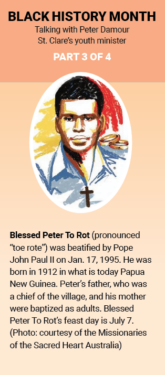Part 3 of 4
A beloved World War II Papuan catechist, martyr
For those young Catholics in the diocese who sometimes feel misunderstood when they want to express their faith publicly in a city like New York, pray to Blessed Peter To Rot for help.
“When we think of saints or holy people, courage should be one of the characteristics that come to mind,” said Peter Damour, youth minister at St. Clare, Rosedale. “Blessed Peter To Rot displayed courage throughout his life.”
Peter To Rot was born in what is today Papua New Guinea. He was the son of the village chief, and he and his parents were baptized as adults and were among the first Catholics in their country.
From an early age, To Rot was interested in his faith. He became one of the youngest catechists in Papua New Guinea, and he always carried a Bible and knew Scriptures by heart. In 1936, he married Paula la Varpit, a Catholic woman from a nearby village.
But World War II changed the lives of the people of Papua New Guinea. When Japanese forces occupied their island, all missionaries were imprisoned. That left Peter as the only spiritual leader in the area. He provided prayer services and instruction, and he helped the poor.
In 1942, the Japanese forbade all Christian worship. But that only encouraged Peter to express his faith more publicly. He was known to hold Catholic prayer services in caves. By 1945, he was arrested and sentenced to prison. Japanese leaders thought the support he received from Catholics was too dangerous. He told his visiting wife that he would die for the church.
Not too long after, he was given a lethal drink and injection. The next morning, he was found dead.
“Peter To Rot reminds us, black Catholics, that the ‘struggle isn’t over’ and that by our very baptism, we are called to be priest, prophet and king,” Damour said. “He was entrusted to uphold the Catechism of the church, even at the cost of his life.”

